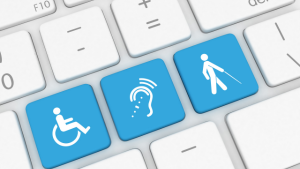If you’ve ever clicked a button and found yourself yanked to another screen without warning, you’ve experienced a “change in context.” It might not seem like a big deal — but for someone using a screen reader or navigating with a keyboard, it can throw them completely off course.
When we’re talking about ADA web accessibility, these unexpected jumps can become real obstacles. I’ve seen websites lose users — and get hit with legal threats — because of things like pop-ups that steal focus or pages that rearrange mid-click. So, let’s break this down.
What Does “Change in Context” Even Mean?
Here’s how I explain it when clients ask: it’s when the user’s environment on a site suddenly shifts in a way they didn’t expect. That could mean:
- The focus jumps somewhere else (like a search bar or unrelated link).
- The viewport changes — for instance, loading a totally different page.
- The user agent changes — maybe a PDF opens or a new tab launches.
- Or the content itself reorders or disappears without warning.
And while none of that is illegal by itself, if your site isn’t giving people a way to keep up — or doesn’t warn them it’s about to happen — you’re asking for trouble. WCAG explains this in detail.
Who Really Struggles with This?
This isn’t about minor inconvenience. I’ve had clients show me cases where users with motor disabilities couldn’t reorient themselves after a modal hijacked the focus. Or blind users navigating by keyboard got stuck in a form because the page shifted on its own.
It’s not just frustrating. It’s exclusionary. And under the ADA, that’s where lawsuits start showing up.
So How Do You Fix It?
Here’s the part most people miss: the goal isn’t to eliminate every change in context. It’s to make them clear and manageable.
Here’s what I do on the sites I audit:
- If a button opens a new window, I tell the user ahead of time. A line like “(opens in new window)” does the job.
- If content loads dynamically, I make sure it’s announced to screen readers using ARIA live regions.
- If something could confuse a keyboard-only user, I test it — personally — with just the tab key.
You don’t need fancy tools for this. You need to walk through your site like someone who can’t see, hear, or use a mouse. That’ll tell you everything you need to know.
A Quick Story
I remember working with a small business owner in New York — let’s call him Marco. He ran a site with a contact form that slid in from the side. Looked slick. Problem was, keyboard users couldn’t even reach it. Worse, they didn’t know it existed.
We fixed it by adding a clear trigger button, making the form reachable by tabbing, and giving screen readers a heads-up when it appeared. That’s all it took. The change? Night and day.
Bottom Line
If your website shifts the ground under your users without warning — you’re putting up barriers. And whether that’s because of a lightbox, a new tab, or something seemingly harmless, it’s on you to fix it.
I help business owners catch these issues before they become legal problems. If you’re not sure where your site stands, it’s better to ask now than after a complaint lands in your inbox.
Want me to take a look at your site? Let’s talk.


